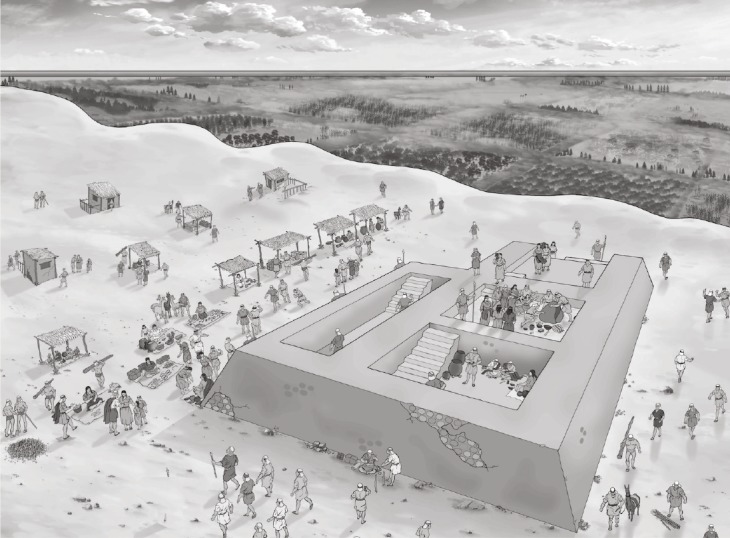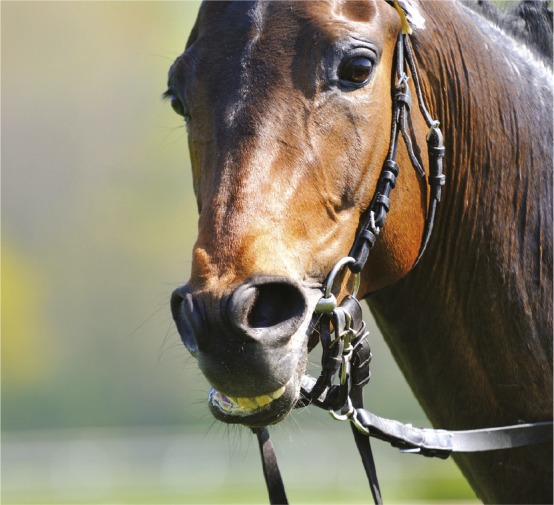Feasting and evolution of social complexity

Artist’s rendering of congregants at Cerro del Gentil. Image courtesy of Robert Gutierrez (artist).
Ritual feasting promoted cohesion and cooperation among early peoples, enabling nonstate societies, which lacked institutions such as markets, policing, and codes of law, to evolve social complexity. Charles Stanish et al. (pp. E6716–E6721) examined the nature and scope of feasting in Paracas, a nonstate society that thrived on the southern coast of Peru between the eighth and third centuries BCE. Through analysis of human skeletal remains and artifacts recovered from Cerro del Gentil—a ceremonial platform mound with sunken, stone-lined courts dating to around 400 to 200 BCE and perched atop agricultural fields at the edge of a pampa—the authors uncovered the provenance and mix of celebrants at lavish ritual feasts now relegated to the annals of antiquity. Strontium isotope ratios in 39 objects, including bones, textiles, baskets, and wooden artifacts, helped reconstruct the mix of participants in prehistoric feasts. The authors used previous estimates of artifacts at a nearby archaeological site to define the local and regional origins of the Cerro del Gentil finds. Twelve of the objects were traced to the courts’ immediate vicinity, whereas 10 objects appeared to have come from afar. Half of these outside objects likely hailed from coastal regions, and the other half, from the highlands. The remaining objects were sourced to Paracas coastal cultures. The strontium data suggests that the Paracas catchment area at Cerro del Gentil likely stretched from Cañete in the north to Nasca in the south, spanning a wide cultural swath collectively called the Paracas polity. According to the authors, social complexity at Paracas may have evolved through the initial inclusion of a diverse and widespread group of people in collective activities such as periodic ritual feasts, rather than through the gradual expansion of a strong but homogeneous coalition of local residents. — P.N.
Human impacts on Toxoplasma gondii diversity
The parasite Toxoplasma gondii is a widespread pathogen that can spread to humans from other animal species, and both diversity and virulence of the pathogen are higher in South America than in the Northern Hemisphere. E. Keats Shwab et al. (pp. E6956–E6963) simulated T. gondii life cycles in domestic and wild environments and traced the origins of the type II strain of T. gondii, common in North America. The results suggest that the development of agriculture and animal domestication decreased animal diversity among agricultural societies and established the domestic cat/mouse transmission cycle of T. gondii, exerting selective pressure that favors the transmission of parasites with reduced virulence in domesticated environments. The authors suggest that strains with intermediate virulence can dominate in domestic life cycles and balance host mortality with the ability to infect animals previously infected with a less virulent strain. According to the authors, the relative absence of such anthropogenic effects in areas such as the Amazon rainforest preserves the diversity and high virulence of T. gondii, which may be increasingly encountered as humans encroach into wild environments. — P.G.
Marine mammal vulnerability to Arctic vessel traffic

Pod of narwhals in central Baffin Bay.
September sea ice cover in the Arctic has retreated by 14% per decade since 1979, lengthening the open-water season and increasing navigability. Consequently, commercial vessel traffic in the Northwest Passage (NWP) through the Canadian Arctic and the Northern Sea Route (NSR) along the Russian Arctic coast has increased, but the potential environmental impacts are poorly understood. Donna Hauser et al. (pp. 7617–7622) examined the vulnerability of 80 subpopulations of seven Arctic marine mammal species to vessel traffic during the open-water season. More than half of these subpopulations were exposed to vessel traffic in either the NWP or NSR. Vulnerability was determined based on a combination of exposure and sensitivity to vessel traffic. Narwhal populations tended to have the highest vulnerability scores, whereas polar bears tended to have the lowest vulnerability. Often the least vulnerable subpopulations also had the greatest uncertainty in vulnerability. Vulnerability was highest in narrow marine passageways, such as the Bering Strait and eastern Canadian Arctic. The results provide a framework for developing conservation measures and highlight areas in need of additional data and monitoring, according to the authors. — B.D.
External light activates hair follicle stem cells in mice
Intrinsically photosensitive retinal ganglion cells (ipRGCs)—a small, atypical subset of photoreceptor cells in the retina—regulate the central circadian clock, pupillary light reflex, and alertness. Although the signaling pathways that ipRGCs trigger in response to external light are well established, far less is known about how otherwise light-insensitive tissues receive light cues from the external environment. Sabrina Mai-Yi Fan et al. (pp. E6880–E6889) report that external light entering the eyes of mice can activate hair follicle stem cells (HFSCs) via ipRGC-mediated signaling. Using a mouse model, the authors found that melanopsin expression by M1-type ipRGCs signals to the suprachiasmatic nucleus (SCN), the region of the hypothalamus thought to regulate the 24-hour circadian clock, thus triggering the release of norepinephrine in the skin and activating HFSCs. The authors also found that the stimulated response is distinct from daily oscillations of the central circadian clock and represents a pathway for immediate cellular responses to environmental light cues. The findings demonstrate a regulatory role for ipRGCs in the autonomous nervous system and suggest that light-mediated ipRGC–SCN signaling may regulate tissue activities in other organs. — T.J.
Horse dentistry may have originated in the Mongolian Steppe

Exploring the origins of equine dentistry. Image courtesy of iStock/pixelnest.
Veterinary dentistry dates back to antiquity, but its precise origin remains unclear, partly because historical records left behind by nomadic peoples are sparse and archaeological finds are shrouded in ambiguity. William Timothy Treal Taylor et al. (pp. E6707–E6715) analyzed well-preserved skeletal remains of horses recovered from tombs and ritual horse burials in the Mongolian Steppe. The authors uncovered evidence of attempted dental surgery, including partially sawn, improperly erupted milk teeth, in the skulls of young horses found at ritual burial sites in Mongolia. Radiocarbon dating of other teeth from the same horses suggested that experimentation with dental procedures began around 1150 BCE, coinciding with the advent of horseback riding among these Mongolian herders. Chronological patterns in horse dentition found in archaeological sites suggest that the practice of removing wolf teeth was tied to the inclusion of bits made of bronze and other metals in bridles, which provided ancient horsemen with improved control; wolf teeth are vestigial premolars commonly removed in modern horse care because their position interferes with bits, triggering pain and damaging tissues. Together, the evidence suggests that innovative forms of equine dental care among nomadic people may have facilitated the eventual emergence of mounted riding and equestrian warfare, according to the authors. — P.N.


